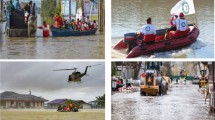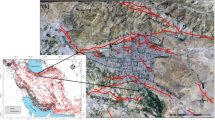Abstract
This paper offers a new robust mathematical model for designing an efficient flood evacuation plan in disasters. The mathematical model takes a set of potential locations for establishing evacuation shelters with limited capacities. We suggest an innovative model to use helicopters to rescue people from the flood for the first time in this field of knowledge. Besides, the helicopters' capacity and maximum flying time are considered limited to adopt real-world conditions. Our goal is to maximize the number of rescued people and to minimize the total cost. By solving the model, we determine the allocation of people to the shelters, the optimal location of shelters, allocation of the helicopters to the evacuation shelters, and flying path and routes of the helicopters. Since the main parameters of the proposed model are due to uncertainty in real-world situations, we implemented robust optimization to formulate uncertainties. Due to the Np-hardness of the suggested formulation, we offer four algorithms to solve the mathematical model. We enhance the efficiency of the algorithms through a robust design of experiments and assess their performance considering several measures via post hoc analysis. At the end, we implement the robust model on real-world data from 2011 Japan’s destructive tsunami in Ishinomaki city. The results reveal that the model is able to provide promising solutions compared to the classical models and leads to higher rescue rates and lower cost.














Similar content being viewed by others
Data availability
Our manuscript has no associated data.
References
Amideo AE, Scaparra MP, Kotiadis K (2019) Optimising shelter location and evacuation routing operations: the critical issues. Eur J Oper Res
Bayram V, Yaman H (2017) Shelter location and evacuation route assignment under uncertainty: a Benders decomposition approach. Transp Sci 52(2):416–436
Bayram V, Yaman H (2018) A stochastic programming approach for shelter location and evacuation planning. RAIRO Oper Res 52(3):779–805
Bae J, Kim MK, Yoo S, Heo J, Sohn HG (2019) Shelter location-allocation for tsunami using floating population and genetic algorithm. J Korean Soc Surv Geodesy Photogramm Cartogr 37(3):157–165
Ben-Tal A, El Ghaoui L, Nemirovski A (2009) Robust optimization, vol 28. Princeton University Press, Princeton
Bertsimas D, Sim M (2004) The price of robustness. Oper Res 52(1):35–53
Chen Z, Chen X, Li Q, Chen J (2013) The temporal hierarchy of shelters: a hierarchical location model for earthquake-shelter planning. Int J Geogr Inf Sci 27(8):1612–1630
Coello CAC, Pulido GT, Lechuga MS (2004) Handling multipleobjectives with particle swarm optimization. IEEE Trans EvolComput 8(3):256–279
Doerner KF, Gutjahr WJ, Nolz PC (2009) Multi-criteria location planning for public facilities in tsunami-prone coastal areas. OR Spectr 31(3):651–678
Dubois D, Prade H (1987) The mean value of a fuzzy number. Fuzzy Sets Syst 24(3):279–300
Dunbar P, McCullough H, Mungov G, Varner J, Stroker K (2011) Tohoku earthquake and tsunami data available from the national oceanic and atmospheric administration/national geophysical data center. Geomatics Nat Hazards Risk 2(4):305–323
Emary E, Zawbaa HM, Hassanien AE (2016) Binary grey wolf optimization approaches for feature selection. Neurocomputing 172:371–381
Esteban M, Takagi H, Mikami T, Aprilia A, Fujii D, Kurobe S, Utama NA (2017) Awareness of coastal floods in impoverished subsiding coastal communities in Jakarta: tsunamis, typhoon storm surges and dyke-induced tsunamis. Int J Disaster Risk Reduct 23:70–79
Fazli-Khalaf M, Khalilpourazari S, Mohammadi M (2017) Mixed robust possibilistic flexible chance constraint optimization model for emergency blood supply chain network design. Ann Oper Res 283:1079–1109
Farahani MM, Chaharsooghi SK, Van Woensel T, Veelenturf LP (2018) Capacitated network-flow approach to the evacuation-location problem. Comput Ind Eng 115:407–426
Gama M, Santos BF, Scaparra MP (2015) A multi-period shelter location-allocation model with evacuation orders for flood disasters. EURO J Comput Optim 1–25.
Ghasemi P, Khalili-Damghani K, Hafezalkotob A, Raissi S (2019) Uncertain multi-objective multi-commodity multi-period multi-vehicle location-allocation model for earthquake evacuation planning. Appl Math Comput 350:105–132
Ghasemi P, Khalili-Damghani K, Hafezalkotob A, Raissi S (2020) Stochastic optimization model for distribution and evacuation planning (A case study of Tehran earthquake). Socio Econ Plan Sci 71:100745
Hammad AW (2019) A Bilevel multi-objective optimisation approach for solving the evacuation location assignment problem. Adv Civ Eng
Haghpanah F, Foroughi H (2018) Optimal shelter location-allocation during evacuation with uncertainties: a scenario-based approach.arXiv:1802.05775
Heilpern S (1992) The expected value of a fuzzy number. Fuzzy Sets Syst 47(1):81–86
Japanese National Police Agency (2011) Damage situation and police countermeasures associated with 2011 Tohoku district—off the Pacific Ocean Earthquake. http://www.npa.go.jp/archive/keibi/biki/higaijokyo_e.pdf. Retrieved 17 May 2011
Jenkins PR, Lunday BJ, Robbins MJ (2020) Robust, multi-objective optimization for the military medical evacuation location-allocation problem. Omega 97:102088
Khalilpourazari S, Mirzazadeh A, Weber GW, Pasandideh SHR (2019a) A robust fuzzy approach for constrained multi-product economic production quantity with imperfect items and rework process. Optimization 1–28
Khalilpourazari S, Naderi B, Khalilpourazary S (2019b) Multi-objective stochastic fractal search: a powerful algorithm for solving complex multi-objective optimization problems. Soft Comput 1–30
Khalilpourazari S, Soltanzadeh S, Weber GW, Roy SK (2020) Designing an efficient blood supply chain network in crisis: neural learning, optimization and case study. Ann Oper Res 289(1):123–152
Khalilpourazari S, Pasandideh SHR (2019) Sine–cosine crow search algorithm: theory and applications. Neural Comput Appl 1–18
Khalilpourazari S, Khalilpourazary S, Çiftçioğlu AÖ, Weber GW (2020b) Designing energy-efficient high-precision multi-pass turning processes via robust optimization and artificial intelligence. J Intell Manuf 1–27
Khalilpourazari S, Pasandideh SHR, Niaki STA (2019) Optimizing a multi-item economic order quantity problem with imperfect items, inspection errors, and backorders. Soft Comput 23(22):11671–11698
Kongsomsaksakul S, Yang C, Chen A (2005) Shelter location-allocation model for flood evacuation planning. J East Asia Soc Transp Stud 6:4237–4252
Liang X, He X, Huang T (2019) Distributed neuro-dynamic optimization for multi-objective power management problem in micro-grid. Neurocomputing 362:51–59
Li L, Jin M, Zhang L (2011) Sheltering network planning and management with a case in the Gulf Coast region. Int J Prod Econ 131(2):431–440
Liu B, Iwamura K (1998) Chance constrained programming with fuzzy parameters. Fuzzy Sets Syst 94(2):227–237
Ma Y, Xu W, Qin L, Zhao X, Du J (2019) Emergency shelters location-allocation problem concerning uncertainty and limited resources: a multi-objective optimization with a case study in the Central area of Beijing, China. Geomat Nat Hazards Risk 10(1):1242–1266
Mirjalili S, Jangir P, Mirjalili SZ, Saremi S, Trivedi IN (2017) Optimization of problems with multiple objectives using the multi-verse optimization algorithm. Knowl Based Syst 134:50–71
Mirjalili S, Mirjalili SM, Lewis A (2014) Grey wolf optimizer. Adv Eng Softw 69:46–61
Mirjalili S, Mirjalili SM, Hatamlou A (2016) Multi-verse optimizer: a nature-inspired algorithm for global optimization. Neural Comput Appl 27(2):495–513
Mori N, Takahashi T, Yasuda T, Yanagisawa H (2011) Survey of 2011 Tohoku earthquake tsunami inundation and run‐up. Geophys Res Lett 38(7)
Niyomubyeyi O, Sicuaio TE, Díaz González JI, Pilesjö P, Mansourian A (2020) A comparative study of four metaheuristic algorithms, AMOSA, MOABC, MSPSO, and NSGA-II for evacuation planning. Algorithms 13(1):16
Park S, Van de Lindt JW, Gupta R, Cox D (2012) Method to determine the locations of tsunami vertical evacuation shelters. Nat Hazards 63(2):891–908
Pishvaee MS, Razmi J, Torabi SA (2012) Robust possibilistic programming for socially responsible supply chain network design: a new approach. Fuzzy Sets Syst 206:1–20
Sofianos NA, Boutalis YS (2016) Robust adaptive multiple models based fuzzy control of nonlinear systems. Neurocomputing 173:1733–1742
Soyster AL (1973) Convex programming with set-inclusive constraints and applications to inexact linear programming. Oper Res 21(5):1154–1157
Swamy R, Kang JE, Batta R, Chung Y (2017) Hurricane evacuation planning using public transportation. Socio Econ Plan Sci 59:43–55
Suppasri A, Leelawat N, Latcharote P, Roeber V, Yamashita K, Hayashi A, Ohira H, Fukui K, Hisamatsu A, Nguyen D, Imamura F (2017) The 2016 Fukushima earthquake and tsunami: Local tsunami behavior and recommendations for tsunami disaster risk reduction. Int J Disaster Risk Reduct 21:323–330
Takabatake T, Shibayama T, Esteban M, Ishii H, Hamano G (2017) Simulated tsunami evacuation behavior of local residents and visitors in Kamakura, Japan. Int J Disaster Risk Reduct 23:1–14
Tao AX, Chang BR, Li CC, Wang DR, Liu ER (2019) Density-sensitive robust fuzzy kernel principal component analysis technique. Neurocomputing 329:210–226
Wang WL, Li WK, Wang Z, Li L (2019) Opposition-based multi-objective whale optimization algorithm with global grid ranking. Neurocomputing 341:41–59
Wang H, Zou Y, Liu PX, Liu X (2018) Robust fuzzy adaptive funnel control of nonlinear systems with dynamic uncertainties. Neurocomputing 314:299–309
Xu W, Zhao X, Ma Y, Li Y, Qin L, Wang Y, Du J (2018) A multi-objective optimization based method for evaluating earthquake shelter location–allocation. Geomat Nat Hazards Risk 9(1):662–677
Yolcu OC, Lam HK (2017) A combined robust fuzzy time series method for prediction of time series. Neurocomputing 247:87–101
Zhao X, Coates G, Xu W (2019) A hierarchical mathematical model of the earthquake shelter location-allocation problem solved using an interleaved MPSO–GA. Geomat Nat Hazards Risk 10(1):1712–1737
Author information
Authors and Affiliations
Corresponding author
Ethics declarations
Conflict of interest
The authors declare that they have no conflict of interest.
Additional information
Publisher's Note
Springer Nature remains neutral with regard to jurisdictional claims in published maps and institutional affiliations.
About this article
Cite this article
Khalilpourazari, S., Pasandideh, S.H.R. Designing emergency flood evacuation plans using robust optimization and artificial intelligence. J Comb Optim 41, 640–677 (2021). https://doi.org/10.1007/s10878-021-00699-0
Accepted:
Published:
Issue Date:
DOI: https://doi.org/10.1007/s10878-021-00699-0




